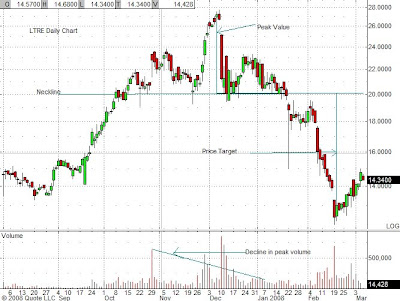
Ameron reported earnings on Feb. 26th. You would think by the 25% one day price drop that earnings were ugly. Had they badly missed estimates? Were there accounting problems? Had the CEO and CFO absconded with corporate profits? The answer is: none of the above. In fact the company reported a healthy 24% gain in sales over last year's quarter and a 14% jump in earnings to $1.07. So what was the problem? The problem is a combination of two things. Although sales beat Wall Street estimates, earnings fell short of the $1.30 estimate. Strike number one. This fact was exacerbated by the recent run-up in share price which reflected investors anticipation of good earnings news. However, their hopes were quickly deflated by the actual numbers thus contributing to the stocks quick and dramatic decline.
If you want another stock that is pooping out on good earnings news, look at the action in Cal-Maine Foods (CALM).

They reported before the market opened this morning. For the fiscal third quarter, they reported higher sales compared with a year ago and their earnings per share tripled, from $0.74 to $2.41. Wow! (As a note, they did not offer any negative guidance and in fact said that they're going to start paying dividends.) In pre-market hours, the stock was trading up. Now, at the close, the stock not only gave up its pre-market gains, but is down over 17% from its intra-day high. This is the stock's biggest one-day loss in a long time.






 The first is Stanley (SXE). It began forming the left shoulder at the beginning of last November and completed its pattern when it fell below the neckline level of $30 almost three months later. Note that volume levels surged at the top of each peak with each succeeding volume level being less than the previous one. At the top of the head, the price was around $38, so we would expect a price target of around $22 ($30 - $8). The price did reach a low of $22.68 on February 14th (Happy Valentine's Day!) before it turned around.
The first is Stanley (SXE). It began forming the left shoulder at the beginning of last November and completed its pattern when it fell below the neckline level of $30 almost three months later. Note that volume levels surged at the top of each peak with each succeeding volume level being less than the previous one. At the top of the head, the price was around $38, so we would expect a price target of around $22 ($30 - $8). The price did reach a low of $22.68 on February 14th (Happy Valentine's Day!) before it turned around. The next example is Learning Tree (LTRE). The left shoulder began forming in the middle of October, the head formed two months later, the right shoulder about three weeks after that until the neckline was finally broken by a downward gap on January 22nd. The peak to neckline value was $7 giving our price target of $13. This value was exceeded by the climactic low on Feb. 19th when the stock bottomed just above $12.
The next example is Learning Tree (LTRE). The left shoulder began forming in the middle of October, the head formed two months later, the right shoulder about three weeks after that until the neckline was finally broken by a downward gap on January 22nd. The peak to neckline value was $7 giving our price target of $13. This value was exceeded by the climactic low on Feb. 19th when the stock bottomed just above $12.